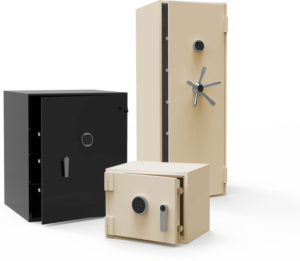UL Certifications

UL Rated Safes are rated according to resistance to entry attempts, protection against fire, and other standardized tests.
Burglary Ratings
Burglary rated safes are rated according to how long they can withstand a burglary attack and what type of tools could be used in this attack. These are determined by a number of factors including the materials the safe is constructed out of, the type of lock used, and other security mechanisms.
Net Working Time: Most UL Rated safes have a number that refers to the time it should take to open up the safe. For example a TL-30 safe should not be able to be opened in under 30 minutes with a given toolset. Standards state that the minimum time any anti theft device must resist attack is 5 minutes. Our safes have a net working time of either 15, 30, or 60 minutes.

- TL – common manual and electric tools such as pry bars, chisels, picks, drills, cutting wheels, grinders, impact hammers, and saws.
- TRTL – same criteria as TL, with the addition of gas powered torches (plasma cutters, gas torches, butane torches, etc).
- TXTL – same criteria as TRTL, with the addition of high powered explosives (up to 4 ounces of nitroglycerin) or 8 ounces of other explosives.
Fire Ratings
Fire resistance ratings are determined by the time a safe should be able to maintain a specific maximum internal temperature. Times range from a 1/2 hour to 4 hours and internal temperatures vary depending on the type of items the safe should hold. Internal temperatures can be either 125°F, 150°F, or 350°F (Class 125, Class 150, Class 350) with the most common rating temperature being 350°F. This is low enough to safely store items such as paper material, jewellery, and most modern electronic media. Class 125 and Class 150 rated safes must also take into consideration relative humidity, as they are typically used to store more delicate items.
Fire rated safes must also undergo explosion and impact tests after the initial endurance test. For the explosion test the safe is heated to 2000°F for between 20 and 30 minutes (depending on the classification) and subsequently the door is opened. This is to test if an explosion could occur during high heat scenarios where oxygen is rapidly introduced. The third test requires safes to be heated between 20-60 minutes (again depending on the classification) and dropped from a height of 30 feet. The safe must remain intact with no openings or critical damage.

